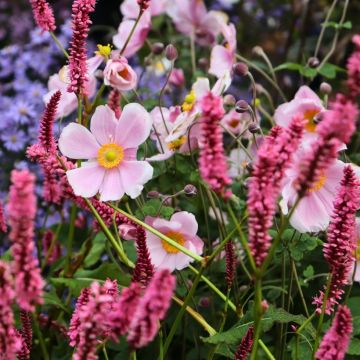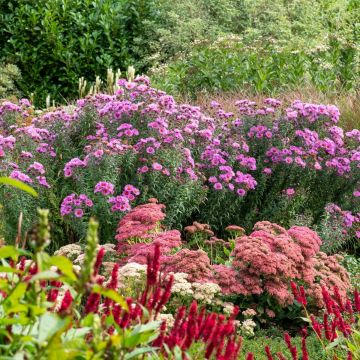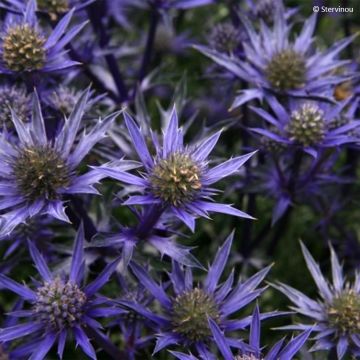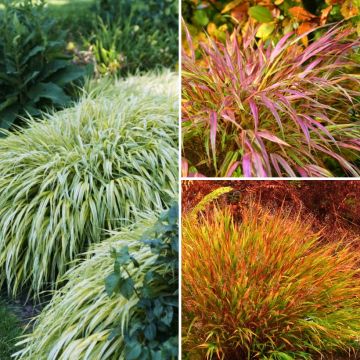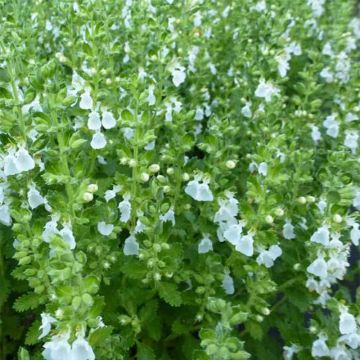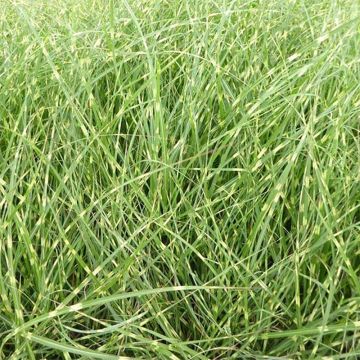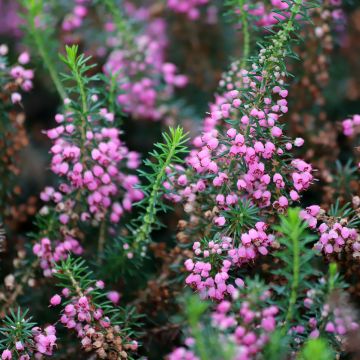

Fascicularia bicolor


Fascicularia bicolor


Fascicularia bicolor
Fascicularia bicolor
Fascicularia bicolor
Crimson Bromeliad
I have been growing this plant for about fifteen years as the sole representative of the Bromeliaceae family in my field of plants. Situated at the base of the house facing southeast, the bush has become enormous (2 x 1 x 0.8 m (3ft)). I bought it in bloom during the plant day at Kervignac in a 5 l pot. It has never bloomed again. ( ! ? ) It's a shame because the flowering is splendid. It receives little water under the roof overhang. Could this be the reason for its failure to flower?
Akebia , 22/07/2020
Special offer!
Receive a €20 voucher for any order over €90 (excluding delivery costs, credit notes, and plastic-free options)!
1- Add your favorite plants to your cart.
2- Once you have reached €90, confirm your order (you can even choose the delivery date!).
3- As soon as your order is shipped, you will receive an email containing your voucher code, valid for 3 months (90 days).
Your voucher is unique and can only be used once, for any order with a minimum value of €20, excluding delivery costs.
Can be combined with other current offers, non-divisible and non-refundable.
Why not try an alternative variety in stock?
View all →This plant carries a 12 months recovery warranty
More information
We guarantee the quality of our plants for a full growing cycle, and will replace at our expense any plant that fails to recover under normal climatic and planting conditions.

Would this plant suit my garden?
Set up your Plantfit profile →
Description
The Fascicularia bicolor is a vigorous perennial, cousin of the billbergias, which is among the most beautiful plants of Chilean origin. It forms a sometimes wide and tall clump of 80 centimetres (32 inches), made up of rosettes of ribbon-like, evergreen leaves. At the end of summer, the central leaves turn a blood red color, while a corymb inflorescence of small pale blue flowers surrounded by white bracts appears in the heart of the rosette. This spectacular plant offers a particularly exotic aspect to the garden throughout the year. Hardy down to -7°C (19.4°F), it thrives in mild climates. As an isolated plant or in a mass planting, in a rockery, this very graphic plant is ideal for mild climate regions. It will also thrive in a large container, to be overwintered in cooler regions.
The Fascicularia bicolor, also known as the andina species, belongs to the bromeliad family, like the pineapple or the guzmania for example. It is native to the Chilean mountains. It is a terrestrial perennial plant, which forms numerous juxtaposed rosettes, with a clump reaching over 1m (3ft) in height and 2m (7ft) in width under optimal conditions. Each rosette is composed of long, dentate and evergreen leaves, glaucous green in color. Its flowering, offering a tricolored spectacle of red, orange and blue, is truly spectacular: at the end of summer or more often in autumn, the leaves located inside the rosettes turn a bright red color, while an inflorescence composed of pale blue flowers mixed with white bracts appears in their heart.
This Fascicularia is a plant that is still little used in our gardens, but of great ornamental value. It is suited for mild climates and well-drained soils, planted in large mass plantings or in a sizable rockery. Used as an isolated plant or planted in groups, the Fascicularia andina structures the space and gives a very exotic charm to the garden. Like large grasses, it is also a wonderful perennial for a modern garden with clean lines. In cold regions, it can be installed in a very large pot on the terrace or balcony, to admire its extraordinary flowering at the end of the season, and overwintered frost-free, in a cold greenhouse or a lightly heated conservatory. In an urban garden, it softens concrete structures. For an exotic and contrasting atmosphere, it can be associated, for example, with the Embothrium coccineum, a small tree with red flowers, the Eccremocarpus scaber (Chilean glory flower), the Pittosporum tenuifolium 'Tom Thumb', proteas, or even the Daturas, plants that, like it, thrive in mild climates.
Report an error about the product description
Fascicularia bicolor in pictures






Flowering
Foliage
Plant habit
Botanical data
Fascicularia
bicolor
Bromeliaceae
Crimson Bromeliad
South America
Other Perennials A to Z
View all →Planting and care
The Fascicularia bicolor is a hardy plant that will be grown in the ground mainly in regions where frost does not go below -7°. Everywhere else, pot cultivation is more suitable, which will allow wintering sheltered from frost, in a cool and bright room.
Install your Fascicularia in a container or a large pot whose bottom has been filled with gravel, shards of pottery or clay balls. The mix that accommodates it should be fertile and well-drained (1/3 leaf soil, 1/3 compost and 1/3 ordinary garden soil, enriched with a handful of crushed horn).
Place the plant in full sun. Water abundantly during the growth period so that the soil never completely dries out. Feed the plant with "special bromelliad plant" fertiliser diluted in the watering can, once a month. In winter, reduce water and fertiliser inputs, and let the soil dry superficially between waterings.
In regions where the climate is mild and frost is light, plant it in the ground, in the sun, in a very well-drained, even sandy or rocky, and fertile soil. In summer, make sure the plant does not lack water. In winter, it can rely on rainwater.
In case of severe frost forecast, install a thick mulch at the base of the plant, and cover it with a winter veil.
Planting period
Intended location
Care
Planting & care advice
-
, onOrder confirmed
Reply from on Promesse de fleurs
Similar products
Haven't found what you were looking for?
Hardiness is the lowest winter temperature a plant can endure without suffering serious damage or even dying. However, hardiness is affected by location (a sheltered area, such as a patio), protection (winter cover) and soil type (hardiness is improved by well-drained soil).

Photo Sharing Terms & Conditions
In order to encourage gardeners to interact and share their experiences, Promesse de fleurs offers various media enabling content to be uploaded onto its Site - in particular via the ‘Photo sharing’ module.
The User agrees to refrain from:
- Posting any content that is illegal, prejudicial, insulting, racist, inciteful to hatred, revisionist, contrary to public decency, that infringes on privacy or on the privacy rights of third parties, in particular the publicity rights of persons and goods, intellectual property rights, or the right to privacy.
- Submitting content on behalf of a third party;
- Impersonate the identity of a third party and/or publish any personal information about a third party;
In general, the User undertakes to refrain from any unethical behaviour.
All Content (in particular text, comments, files, images, photos, videos, creative works, etc.), which may be subject to property or intellectual property rights, image or other private rights, shall remain the property of the User, subject to the limited rights granted by the terms of the licence granted by Promesse de fleurs as stated below. Users are at liberty to publish or not to publish such Content on the Site, notably via the ‘Photo Sharing’ facility, and accept that this Content shall be made public and freely accessible, notably on the Internet.
Users further acknowledge, undertake to have ,and guarantee that they hold all necessary rights and permissions to publish such material on the Site, in particular with regard to the legislation in force pertaining to any privacy, property, intellectual property, image, or contractual rights, or rights of any other nature. By publishing such Content on the Site, Users acknowledge accepting full liability as publishers of the Content within the meaning of the law, and grant Promesse de fleurs, free of charge, an inclusive, worldwide licence for the said Content for the entire duration of its publication, including all reproduction, representation, up/downloading, displaying, performing, transmission, and storage rights.
Users also grant permission for their name to be linked to the Content and accept that this link may not always be made available.
By engaging in posting material, Users consent to their Content becoming automatically accessible on the Internet, in particular on other sites and/or blogs and/or web pages of the Promesse de fleurs site, including in particular social pages and the Promesse de fleurs catalogue.
Users may secure the removal of entrusted content free of charge by issuing a simple request via our contact form.
The flowering period indicated on our website applies to countries and regions located in USDA zone 8 (France, the United Kingdom, Ireland, the Netherlands, etc.)
It will vary according to where you live:
- In zones 9 to 10 (Italy, Spain, Greece, etc.), flowering will occur about 2 to 4 weeks earlier.
- In zones 6 to 7 (Germany, Poland, Slovenia, and lower mountainous regions), flowering will be delayed by 2 to 3 weeks.
- In zone 5 (Central Europe, Scandinavia), blooming will be delayed by 3 to 5 weeks.
In temperate climates, pruning of spring-flowering shrubs (forsythia, spireas, etc.) should be done just after flowering.
Pruning of summer-flowering shrubs (Indian Lilac, Perovskia, etc.) can be done in winter or spring.
In cold regions as well as with frost-sensitive plants, avoid pruning too early when severe frosts may still occur.
The planting period indicated on our website applies to countries and regions located in USDA zone 8 (France, United Kingdom, Ireland, Netherlands).
It will vary according to where you live:
- In Mediterranean zones (Marseille, Madrid, Milan, etc.), autumn and winter are the best planting periods.
- In continental zones (Strasbourg, Munich, Vienna, etc.), delay planting by 2 to 3 weeks in spring and bring it forward by 2 to 4 weeks in autumn.
- In mountainous regions (the Alps, Pyrenees, Carpathians, etc.), it is best to plant in late spring (May-June) or late summer (August-September).
The harvesting period indicated on our website applies to countries and regions in USDA zone 8 (France, England, Ireland, the Netherlands).
In colder areas (Scandinavia, Poland, Austria...) fruit and vegetable harvests are likely to be delayed by 3-4 weeks.
In warmer areas (Italy, Spain, Greece, etc.), harvesting will probably take place earlier, depending on weather conditions.
The sowing periods indicated on our website apply to countries and regions within USDA Zone 8 (France, UK, Ireland, Netherlands).
In colder areas (Scandinavia, Poland, Austria...), delay any outdoor sowing by 3-4 weeks, or sow under glass.
In warmer climes (Italy, Spain, Greece, etc.), bring outdoor sowing forward by a few weeks.
































